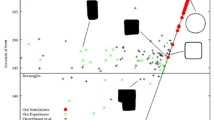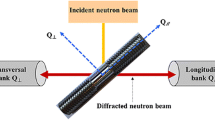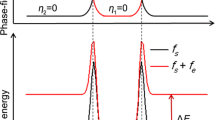Abstract
The unique combination of high strength and high fracture toughness in maraging steels is attributed to the precipitation of mainly two phases, Ni3Mo and Ni3Ti, in the soft bcc martensitic matrix. Experimentally, it is difficult to distinguish between these phases; moreover, the effect of each precipitating phase on the properties of the steel is ambiguous. In the present work, we tackle these questions by analyzing the elastic fields and elastic energy associated with each precipitating phase and their role in the determination of the shape and relative arrangement. Using a semi-analytic approach based on the solution of the equations of elasticity by Fourier transform, the elastic fields and elastic energy associated with each precipitate were calculated. The calculations show that the minimum self-energy of both precipitates is accomplished when the smallest crystallographic misfit lies parallel to the longest geometric axis. The combination of elastic energy and surface energy provides an explanation to the observed morphologies of the precipitates, each type having an elongated shape but with a different aspect ratio. According to the calculations, the minimum self-elastic energy associated with Ni3Ti coherent precipitate is 2.8-fold larger than the energy of Ni3Mo. This implies for a larger strengthening effect of the former, as was confirmed experimentally in model alloys, one without Mo and the other without Ti. The elastic model also predicts that elongated shape and the anisotropic misfit strains favor several vertical arrangements of both precipitates, as was also verified experimentally by transmission electron microscopy of aged model alloys.











Similar content being viewed by others
Notes
The surface area of a thin plate is approximately \( 2\pi a_{1}^{2}, \) and the surface area of a thin rod is nearly \( 2\pi a_{2} c_{2} \). Assuming equal volumes, the surface area of the plate is larger than the area of the rod when \( a_{1} > \left( {\beta_{1} /\beta_{2} } \right)c_{2} \). According to Fig. 6b, the elastic energy of a rod with β 2 = 20 is equal to that of a plate with β 1 = 0.2. For this situation, the surface area of the plate is larger when a 1 > 0.01c 2, which is an obvious relation for precipitates in solids.
References
Decker RF, Eash JT, Goldman AJ (1962) Eighteen percent nickel maraging steel. Trans ASM 55:58–76
Floreen S (1968) The physical metallurgy of maraging steels. Inter Mater Rev 13:115–128
Rohrbach K, Schmidt M (1991) Maraging steel in ASM Handbook, vol 1. ASM International Handbook, OH, pp 793–800
Rao MN (2006) Progress in understanding the metallurgy of 18% nickel maraging steel. Int J Mater Res 97:1594–1607
Moshka O, Pinkas M, Brosh E, Ezersky V, Meshi L (2013) MSc thesis, Ben-Gurion University of the Negev, Beer-Sheva, unpublished research
Jagle EA, Choi PP, Humbeeck JV, Raabe D (2014) Precipitation and austenite reversion behavior of maraging steel produced by selective laser melting. J Mater Res 17:2072–2079
Dmitrievas O, Choi P, Gerstl SSA, Raabe D (2011) Pulsed-laser atom probe studies of a precipitation hardened maraging TRIP steel. Ultramicroscopy 111:623–627
Dmitrieva O, Ponge D, Inden G, Millán J, Choi P, Sietsma J, Raabe D (2011) Chemical gradients across phase boundaries between martensite and austenite in steel studied by atom probe tomography and simulation. Acta Mater 59:364–374
Millán J, Raabe D, Choi P, Dmitrieva O (2011) Characterization of nano-sized precipitates in Mn-based lean Maraging steel by atom probe tomography. Steel Res 82:137–145
Raabe D, Ponge D, Dmitrieva O, Sander B (2009) Nanoprecipitate-hardened 1.5 GPa steels with unexpected high ductility. Scripta Mater 60:1141–1144
Eshelby JD (1961) Elastic inclusions and inhomogeneities. In: Sneddon NI, Hill R (eds) Progress in solid mechanics, vol 2. North Holland, Amsterdam, p 89 [(a) discussion of eq. 2.26]
Mura T (1987) Micromechanics of defects in solids, 2nd edn. Martinus Nijhoff, Boston
Khachaturyan AG (1983) Theory of structural transformations in solids. Wiley, New York
Shneck RZ (2001) Microstructural shape evolution of γ’ in nickel-based superalloys by stress-assisted diffusion. Philos Mag A 2:383–389
Kang SJ, Kim YW, Kim M, Zuo J (2014) Determination of interfacial atomic structure, misfits and energetics of Ω phase in Al–Cu–Mg–Ag alloy. Acta Mater 81:501–511
Fallah V, Korinek A, Opoku NO, Raeisinia B, Gallerneault M, Provatas N, Esmaeili S (2015) Atomic-scale pathway of early-stage precipitation in Al–Mg–Si alloys. Acta Mater 82:457–467
Ji YZ, Issa A, Heo TW, Saal JE, Wolverton C, Chen L-Q (2014) Predicting β′ precipitate morphology and evolution in Mg–RE alloys using a combination of first-principles calculations and phase-field modeling. Acta Mater 76:259–271
Kurdjumov G, Sachs G (1930) Über den mechanismus der stahlhärtung. Zeitschrift für Physik 64:325–343
Li X, Yin Z (1995) A computer-simulated electron diffraction analysis of precipitates in 18 Ni (350) maraging steel. Materials Letter 23:269–272
Pereloma EV, Shekhter A, Miller MK, Ringer SP (2004) Ageing behaviour of an Fe–20Ni–1.8Mn–1.6Ti–0.59Al (wt%) maraging alloy: clustering precipitation and hardening. Acta Mater 52:5589–5602
Schmidt M, Rohrbach K (1991) Heat treating of maraging steels in ASM handbook, vol 4, heat treating. ASM International Handbook, OH, pp 219–228
Choi BI, Earmme YY (1986) Interactions of spherical precipitates in an anisotropic matrix. Mech Mater 5:121–136
Johnson WC, Lee JO (1986) Elastic fields of inhomogeneous precipitate in Phase transformation. Elsevier, Amsterdam, pp 115–139
Millán J, Sandlöbes S, Al-Zubi A, Hickel T, Choi P, Neugebauer J, Ponge D, Raabe D (2014) Designing Heusler nanoprecipitates by elastic misfit stabilization in Fe–Mn maraging steels. Acta Mater 76:94–105
Acknowledgments
The authors thank Mr. O. Omasi for the preparation of the model alloys. This study was supported by the joint IAEC-UPBC Pazy foundation.
Author information
Authors and Affiliations
Corresponding author
Rights and permissions
About this article
Cite this article
Shmulevitsh, M., Meshi, L., Pinkas, M. et al. Elastic consideration of the precipitation in model alloys of maraging steels: theory and experimental validation. J Mater Sci 50, 4970–4979 (2015). https://doi.org/10.1007/s10853-015-9044-7
Received:
Accepted:
Published:
Issue Date:
DOI: https://doi.org/10.1007/s10853-015-9044-7




